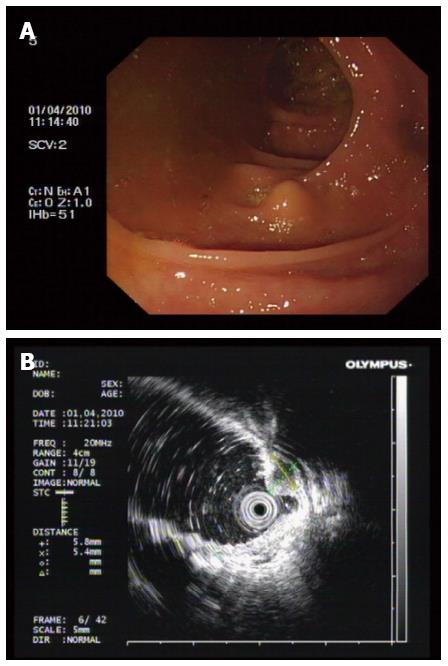Copyright
©The Author(s) 2015.
World J Gastroenterol. Dec 28, 2015; 21(48): 13542-13547
Published online Dec 28, 2015. doi: 10.3748/wjg.v21.i48.13542
Published online Dec 28, 2015. doi: 10.3748/wjg.v21.i48.13542
Figure 1 Preoperative examination.
A: A 0.8 cm submucosal lesion was observed 60 cm from the anal verge (ascending colon). The mass was sessile, the mucosal surface was smooth, with non-necrotic erosion, and was non-circumferential. B: Ultrasonographic examination revealed a 0.5 cm hypoechoic submucosal lesion without muscularis propria involvement.
Figure 2 Endoscopic submucosal dissection procedure.
A: A 1.0 cm × 1.2 cm hemispherical submucosal lesion which had a hard texture, fixed, smooth surface, was observed in the ileocecal junction; B: Saline solution with a small amount of epinephrine and indigo carmine was injected beneath the lesion, and resulted in good elevation; C: Complete dissection of the lesion after circumferential incision; D: The lesion was completely removed without any bleeding or perforation; E: Purse-string suture with metallic clips and endoloop; F: Dissected specimen was sent for pathologic examination.
Figure 3 Pathologic findings.
A: Infiltrative growth pattern of colorectal granular cell tumor (× 400); B: Tumor cells were strongly positive for cytoplasmic S-100 protein (+++) (× 400).
- Citation: Take I, Shi Q, Qi ZP, Cai SL, Yao LQ, Zhou PH, Zhong YS. Endoscopic resection of colorectal granular cell tumors. World J Gastroenterol 2015; 21(48): 13542-13547
- URL: https://www.wjgnet.com/1007-9327/full/v21/i48/13542.htm
- DOI: https://dx.doi.org/10.3748/wjg.v21.i48.13542











